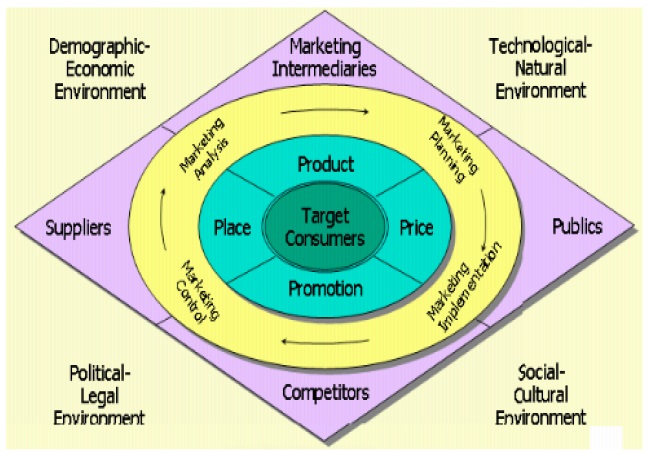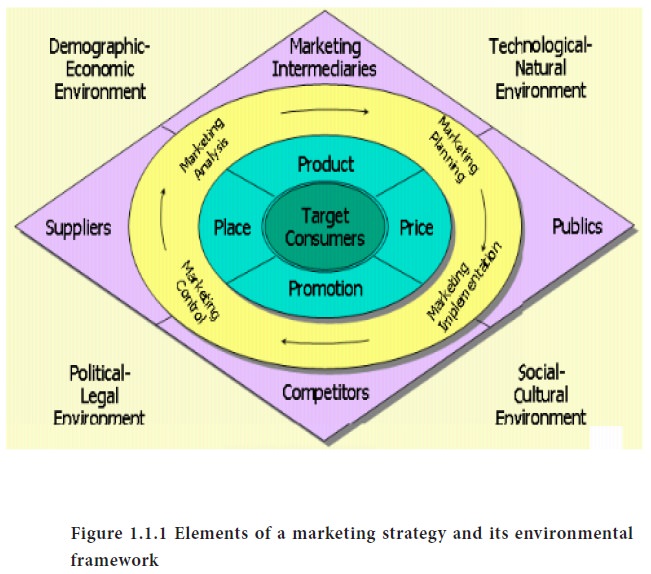MARKETING MANAGEMENT - Introduction to Marketing
Marketing Framework - Introduction to Marketing
Posted On :

The basic elements of a marketing strategy consist of (1) the target market, and (2) the marketing mix variables of product, price, place and promotion that combine to satisfy the needs of the target market.
Marketing Framework
The basic elements of a marketing strategy consist of (1) the target market, and (2) the marketing mix variables of product, price, place and promotion that combine to satisfy the needs of the target market. The outer circle in Figure 1.1.1 lists environmental characteristics that provide the framework within which marketing strategies are planned.

Marketing activities focus on the consumer. Therefore, a market-driven organization begins its overall strategy with a detailed description of its target market: the group of people toward whom the firm decides to direct its marketing efforts.
After marketers select a target market, they direct their activities towards profitably satisfying that target segment. Although they must manipulate many variables to reach this goal, marketing decision making can be divided into four areas: product, price, place (distribution) and promotion (marketing communication). These 4 Ps of marketing are referred to as the marketing mix. The 4 Ps blend to fit the needs and preferences of a specific target market. These are the four variables that a
Figure 1.1.1 illustrates the focus of the marketing mix variables on the central choice of consumer or organizational target markets.
1. The product strategy involves deciding what goods and services the firm should offer to a group of consumers and also making decisions about customer service, brand name, packaging, labeling, product life cycles and new product development.
2. The pricing strategy deals with the methods of setting profitable and justifiable prices. Marketers develop place (distribution) strategy to ensure that consumers find their products available in the proper quantities at the right times and places.
3. Place strategy involve decisions related to the distribution functions and marketing intermediaries (channel members).
4. In the promotional strategy, marketers blend together the various elements of promotion to communicate most effectively with their target market. Many firms use an approach called Integrated Marketing Communications (IMC) to coordinate all promotional activities so that the consumer receives a unified, consistent and effective message.
Environmental factors. Unlike the controllable marketing mix elements, the environmental variables frequently lie outside the control of marketers. Marketers do not make decisions about target markets and marketing mix variables in a vacuum. They must take into account the dynamic nature of the five marketing environmental dimensions as shown in Figure 1.1.1 – competitive, political-legal, economic, technological and social-cultural dimensions.
1. Marketers compete for the same consumers. So the developments in the competitive environment will have lot of repercussions.
3. The economic environment dictates the mood in the target market participants who take decisions such as to buy or save, to buy now or later.
4. The technological environment can spell life or death for a marketer with break-through technologies. Marketers often leap forward or get left behind owing to the changes in the technological environment.
5. The social-cultural environment offers cues for the marketers to ‘connect’ well with the target market. Failure on part of the marketer to understand the social-cultural environment will have serious consequences. A marketers can not afford to rub a society/culture on the wrong side!
The basic elements of a marketing strategy consist of (1) the target market, and (2) the marketing mix variables of product, price, place and promotion that combine to satisfy the needs of the target market. The outer circle in Figure 1.1.1 lists environmental characteristics that provide the framework within which marketing strategies are planned.

Target consumers
Marketing activities focus on the consumer. Therefore, a market-driven organization begins its overall strategy with a detailed description of its target market: the group of people toward whom the firm decides to direct its marketing efforts.
Marketing mix
After marketers select a target market, they direct their activities towards profitably satisfying that target segment. Although they must manipulate many variables to reach this goal, marketing decision making can be divided into four areas: product, price, place (distribution) and promotion (marketing communication). These 4 Ps of marketing are referred to as the marketing mix. The 4 Ps blend to fit the needs and preferences of a specific target market. These are the four variables that a
Figure 1.1.1 illustrates the focus of the marketing mix variables on the central choice of consumer or organizational target markets.
1. The product strategy involves deciding what goods and services the firm should offer to a group of consumers and also making decisions about customer service, brand name, packaging, labeling, product life cycles and new product development.
2. The pricing strategy deals with the methods of setting profitable and justifiable prices. Marketers develop place (distribution) strategy to ensure that consumers find their products available in the proper quantities at the right times and places.
3. Place strategy involve decisions related to the distribution functions and marketing intermediaries (channel members).
4. In the promotional strategy, marketers blend together the various elements of promotion to communicate most effectively with their target market. Many firms use an approach called Integrated Marketing Communications (IMC) to coordinate all promotional activities so that the consumer receives a unified, consistent and effective message.
Environmental factors. Unlike the controllable marketing mix elements, the environmental variables frequently lie outside the control of marketers. Marketers do not make decisions about target markets and marketing mix variables in a vacuum. They must take into account the dynamic nature of the five marketing environmental dimensions as shown in Figure 1.1.1 – competitive, political-legal, economic, technological and social-cultural dimensions.
1. Marketers compete for the same consumers. So the developments in the competitive environment will have lot of repercussions.
2. The
political-legal environment includes the governing and regulatory bodies
that impose guidelines
to the marketers.
Adherence
to the law of the land is an imperative for a marketer to be a good and
responsible corporate citizen.3. The economic environment dictates the mood in the target market participants who take decisions such as to buy or save, to buy now or later.
4. The technological environment can spell life or death for a marketer with break-through technologies. Marketers often leap forward or get left behind owing to the changes in the technological environment.
5. The social-cultural environment offers cues for the marketers to ‘connect’ well with the target market. Failure on part of the marketer to understand the social-cultural environment will have serious consequences. A marketers can not afford to rub a society/culture on the wrong side!
Tags : MARKETING MANAGEMENT - Introduction to Marketing
Last 30 days 741 views












